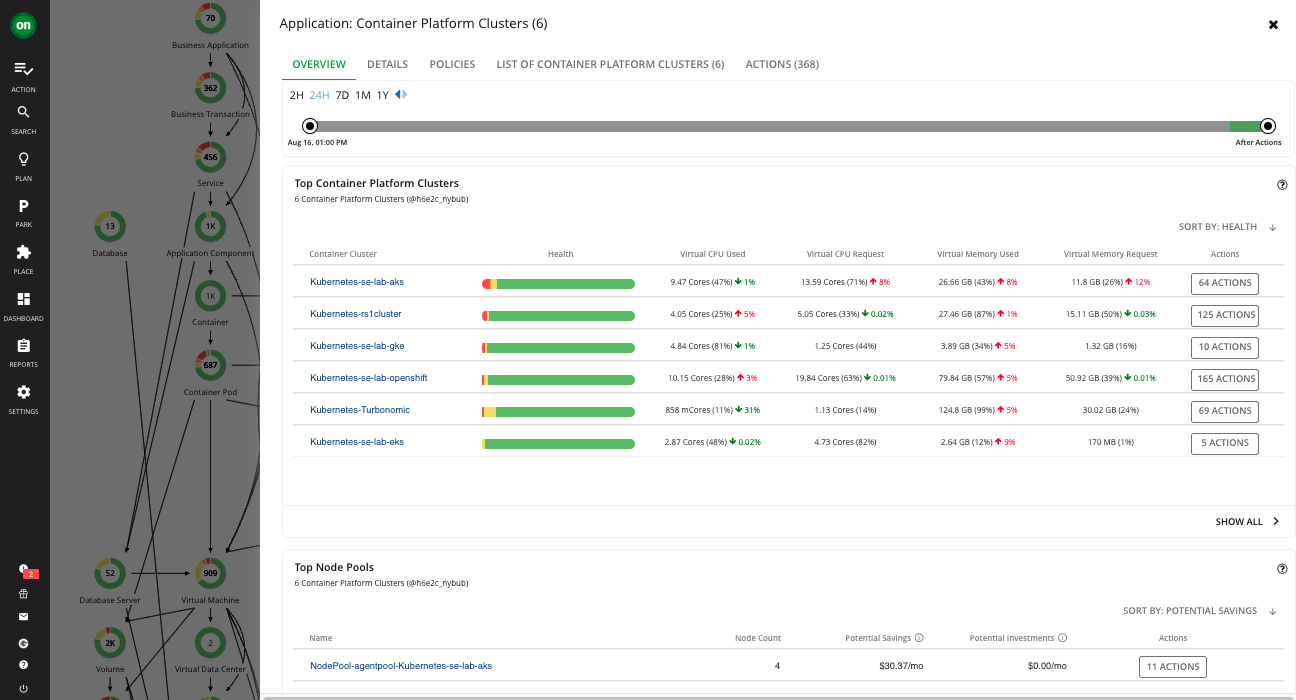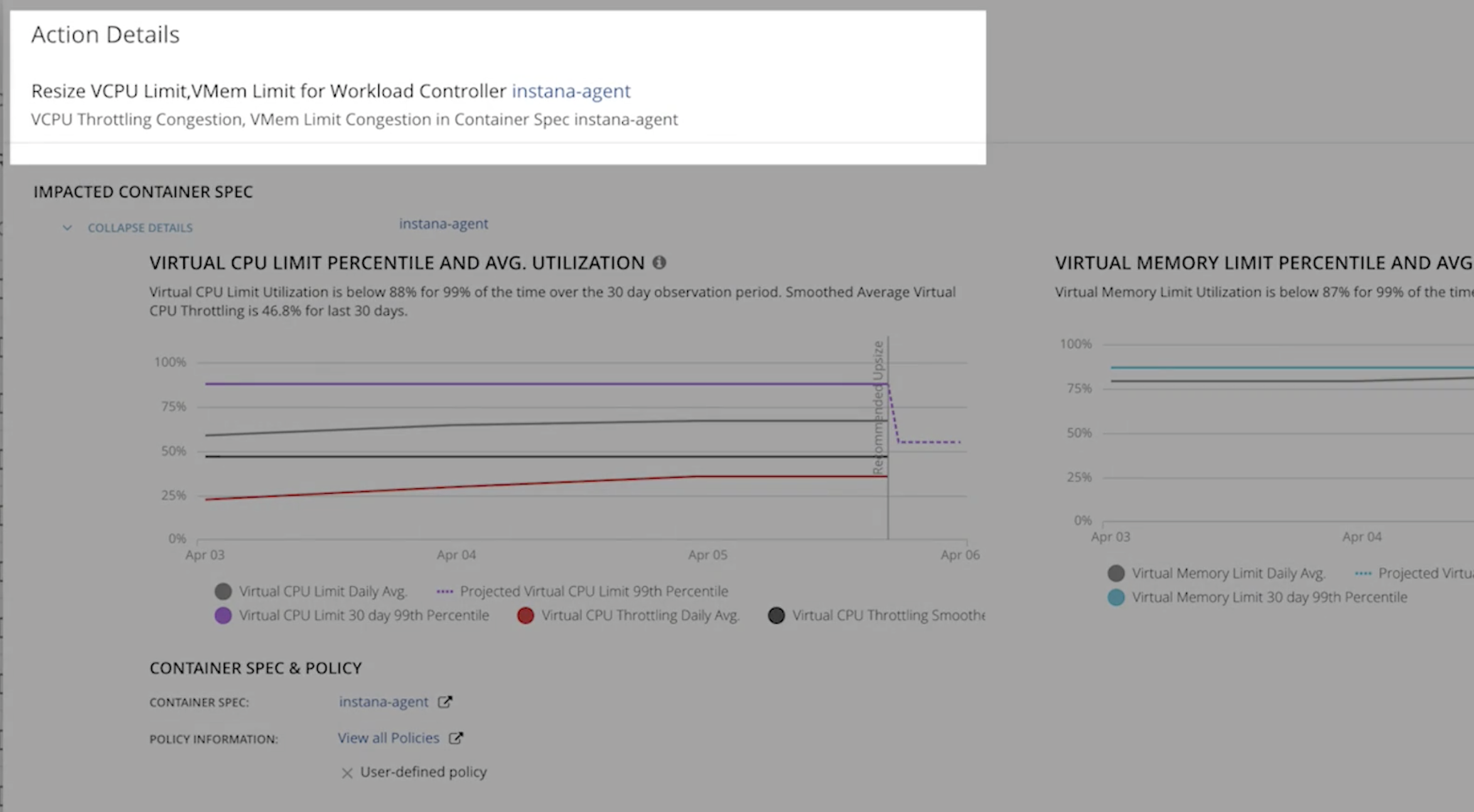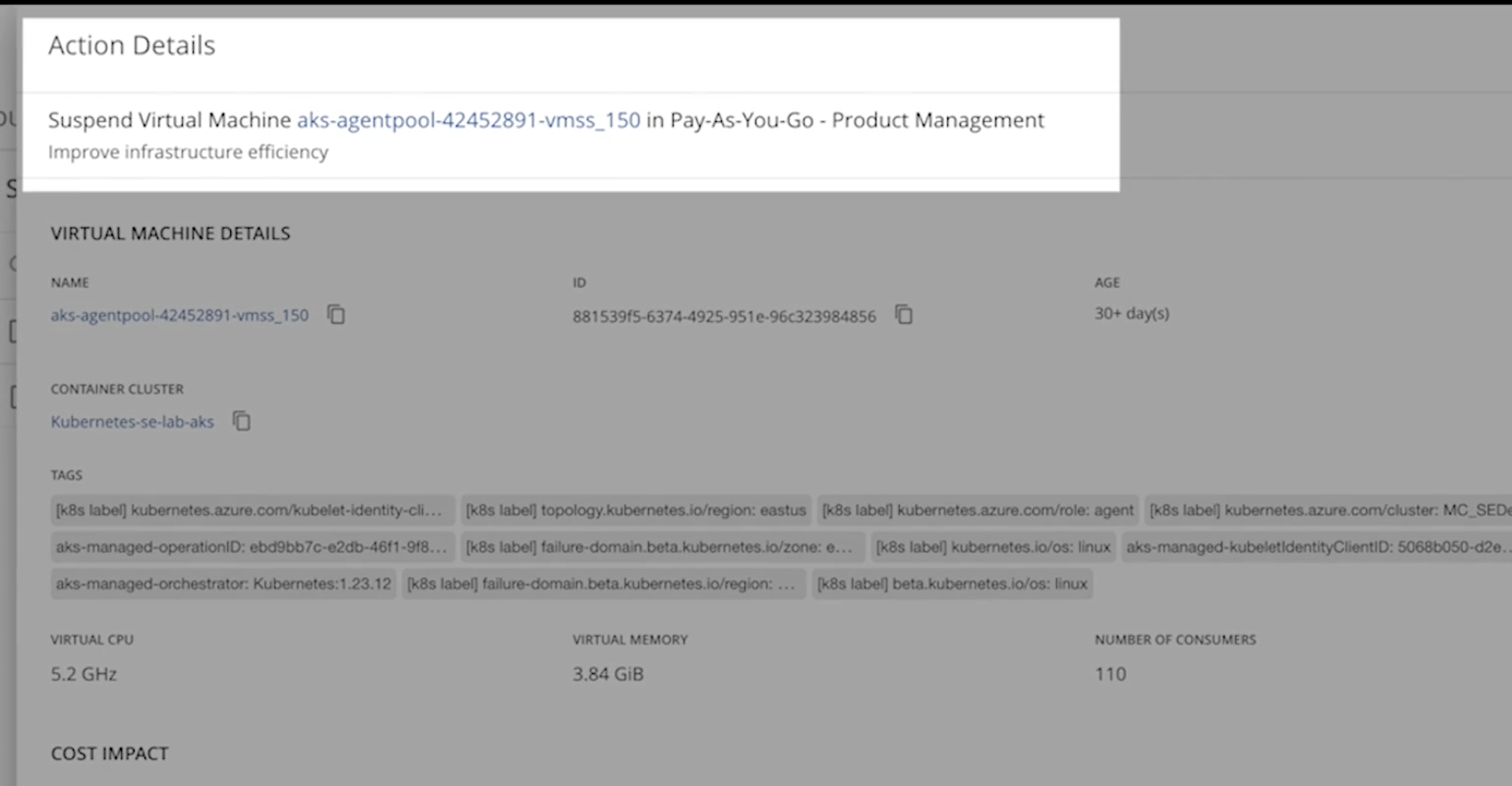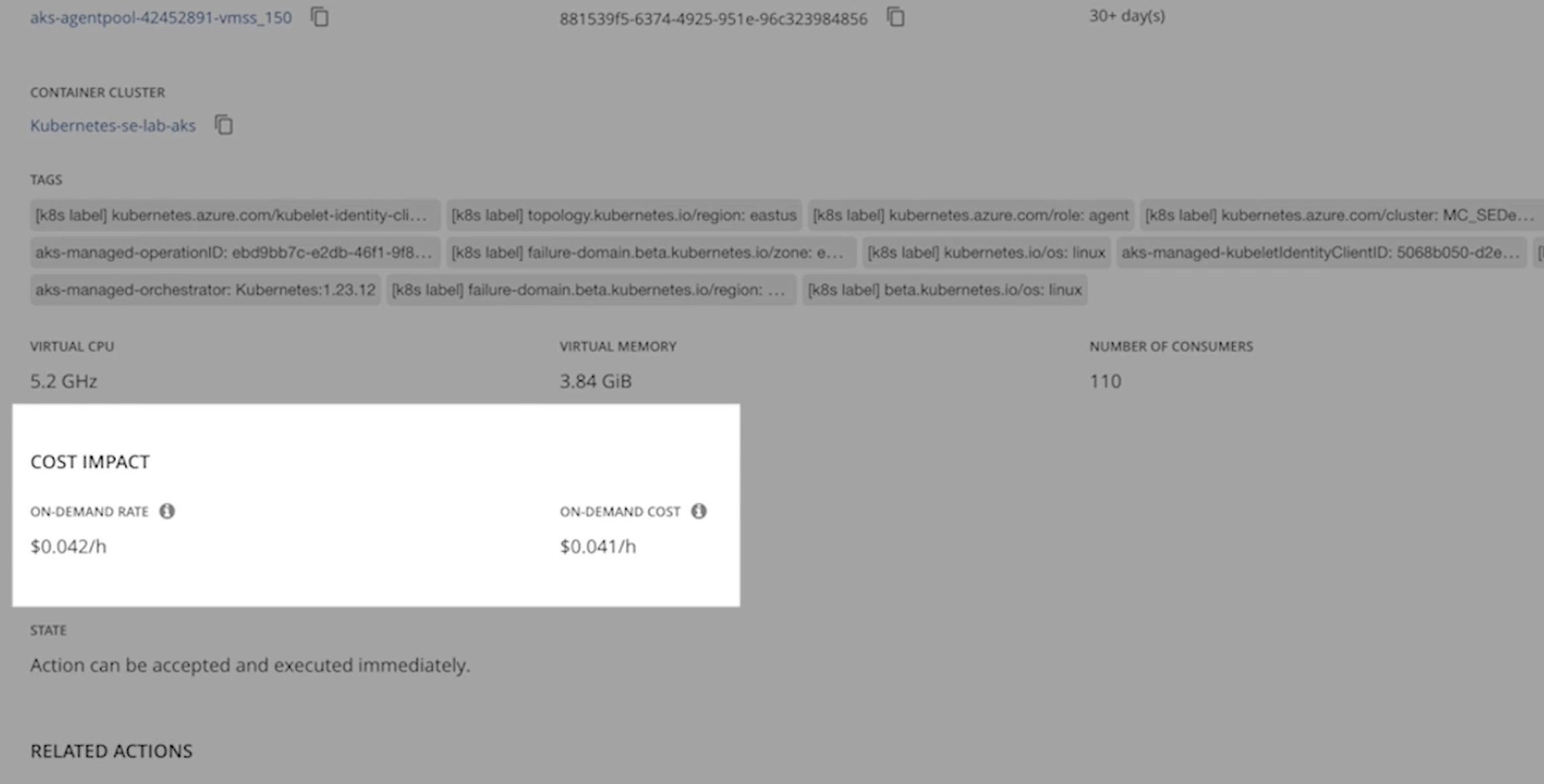
The race to innovate has likely left you (and many, many others) with unexpectedly high cloud bills and/or underutilized resources. In fact, according to Flexera’s 2023 State of the Cloud report, for the first time in a decade, “managing cloud spend” (82%) surpassed “security” (79%) to become the number one challenge facing organizations across the board.
We get it. Overprovisioning is the go-to strategy for avoiding performance risks.
Trying to find the balance between performance and efficiency is anything but a walk in the park. Sure, there are endless Kubernetes cost monitoring tools available that allow you to keep tabs on various aspects of your cluster’s resource usage, like CPU, memory, storage and network. Tracking these metrics can help identify resource-intensive workloads, inefficient resource allocation or unnecessary resource consumption that may lead to increased costs.
All this time-consuming monitoring is closely followed by the labor-intensive work of rightsizing containers and setting auto-scaling policies and thresholds.
Hello, automation
IBM Turbonomic optimizes your Kubernetes environment through container rightsizing, pod suspension and provisioning, pod moves and cluster scaling actions. Every layer of the stack is analyzed and resourced based on real-time demand—from pods and services to containers to nodes, as well as the underlying cloud infrastructure. It’s purpose-built to help your teams automate and quickly achieve significant and continuous results.
Turbonomic supports all upstream versions of Kubernetes—Red Hat OpenShift, EKS, AKS, GKE and more—on any cloud, in any data center and with any hybrid or multicloud combination. It understands the resource needs of your applications and continuously determines the actions that ensure the apps get exactly what they need to perform.
Let’s begin by looking at your container clusters.

Here you see your top clusters sorted by health, followed by top node pools sorted by potential savings. This dashboard provides a great overview of what you want to keep an eye on, but let’s take a look at what really matters—the actions.

In this example, we see an action to resize a workload controller (a container). As the action shows, resizing here will improve performance. With Turbonomic, every action includes the data to back it up, as well as details around the action’s impact.

In this next example, we see an action to suspend a node, which will improve efficiency. By how much, you ask?

Look at how much is saved just by suspending this one unused node.
Still, it can be unnerving for application owners and development teams to scale back resources. We get it. Performance is paramount.
Turbonomic is all about performance
Turbonomic makes sure your apps get exactly what they need when they need it. The efficiency gains are a byproduct of that.
Have your app owner take it. It’s a low-risk way to get comfortable with automation. In fact, some of these actions are non-disruptive and reversible.
Again, because every action also comes with metrics and the reasoning behind it, teams have an easier time trusting the decision to act. You need that trust in order to move from human decision-making to operationalizing automation.
An observability platform’s best friend
If you have application data from critical tools like IBM Instana Observability or any other application performance monitoring (APM) solution, Turbonomic can understand the response time and transactions of the application, stitching this application data to the Kubernetes platform and the infrastructure on which it runs.

You and everyone else see exactly how dynamic resourcing improves application performance while minimizing cost.

See here—even as demand fluctuates, response times are kept low.
If you have predefined service level objectives (SLOs), Turbonomic can ingest that data to dynamically scale microservice applications out and back based on demand to ensure those SLOs are always met. SLO policies can also be configured directly on the platform.
You can gradually take more and more actions, then integrate them with your pipelines and processes. Whether it’s Slack, GitOps, TerraForm, Ansible, ServiceNow or others, Turbonomic’s got you covered.
Feel free to start with small steps to get started, but unlocking Kubernetes elasticity for continuous performance at the lowest cost requires automation.
Let IBM Turbonomic handle it
With Turbonomic, you can automate these micro-improvements at a rate that exceeds human scale. Remove the labor-intensive work of rightsizing containers and setting auto-scaling policies and thresholds and let the software do it for you based on real-time application demand. The cumulative effect of these micro-improvements is Kubernetes applications that perform exactly like they should at the lowest cost possible.
In other words, put those performance-risk nightmares to bed.
Get started with IBM Turbonomic or request a demo with one of our experts today.
Request an IBM Turbonomic demo
More from IBM Turbonomic

6 considerations to take when approximating cloud spend
5 min read – Cloud computing can add a collective $3 trillion to organizations that harness it correctly, according to McKinsey. It is poised to transform businesses and industries, revolutionize how employees and other stakeholders collaborate, and drive digital transformation initiatives. Many organizations have spent the past few years investing heavily in the cloud. Gartner predicted that cloud spending would reach nearly $600 billion by the end of 2023. There are many reasons why organizations have embraced cloud services, including improved efficiencies, cost savings,…
5 min read

Measuring the impact: Unveiling the savings realized in cloud cost optimization
3 min read – Imagine embarking on a weight-loss journey without having a scale—it’s like sailing through uncharted waters without a compass. The scale serves as your trusted navigator, providing tangible metrics and keeping you on track. Similarly, comprehending the savings realized in a cloud-cost-optimization journey offers valuable insights into the impact of your efforts. It’s like having a financial guide by your side, showing you the tangible benefits of your optimization strategies and motivating you to keep pushing forward. It highlights the areas…
3 min read

AWS cloud migration with IBM Turbonomic
4 min read – Organizations worldwide are embracing the power of cloud computing to drive innovation, enhance scalability and improve operational efficiency. Among the various cloud service providers available, Amazon Web Services (AWS) has emerged as a popular choice for businesses seeking digital transformation. The flexibility, scalability and breadth of services offered by AWS have enticed organizations to migrate their workloads to the cloud giant. However, while the benefits of such a migration are substantial, there are critical considerations that must not be overlooked. …
4 min read

New IBM Turbonomic reporting dashboards to empower IT operations for success
3 min read – Gaining insights into application performance and resource utilization is critical to keep your business performing at its best. Having detailed reporting dashboards to provide real-time insights, visualizations and centralized data enables efficient decision-making and proactive management, which are very important to the health of your applications. That’s why we are happy to announce that IBM is launching new Turbonomic Reporting Dashboards, now available for Turbonomic SaaS customers with the rollout of IBM Turbonomic version 8.9.6. The new enhanced reporting dashboards…
3 min read
- SEO Powered Content & PR Distribution. Get Amplified Today.
- PlatoData.Network Vertical Generative Ai. Empower Yourself. Access Here.
- PlatoAiStream. Web3 Intelligence. Knowledge Amplified. Access Here.
- PlatoESG. Automotive / EVs, Carbon, CleanTech, Energy, Environment, Solar, Waste Management. Access Here.
- PlatoHealth. Biotech and Clinical Trials Intelligence. Access Here.
- ChartPrime. Elevate your Trading Game with ChartPrime. Access Here.
- BlockOffsets. Modernizing Environmental Offset Ownership. Access Here.
- Source: https://www.ibm.com/blog/kubernetes-cost-savings/
- :has
- :is
- :not
- $3
- $UP
- 11
- 14
- 15%
- 16
- 17
- 2023
- 30
- 300
- 40
- 46
- 700
- 8
- 9
- a
- About
- According
- Achieve
- across
- Act
- Action
- actions
- add
- Advertising
- All
- allocation
- allow
- also
- always
- Amazon
- Amazon Web Services
- Amazon Web Services (AWS)
- among
- amp
- an
- analytics
- analyzed
- and
- Announce
- any
- anything
- app
- Application
- applications
- apps
- ARE
- around
- article
- AS
- asian
- aspects
- At
- AUGUST
- author
- automate
- Automation
- available
- avoiding
- AWS
- back
- Balance
- based
- BE
- because
- become
- begin
- behind
- benefits
- BEST
- between
- Billion
- Bills
- Blog
- blogs
- board
- breadth
- budget
- business
- businesses
- but
- by
- calculating
- CAN
- carbon
- card
- Cards
- CAT
- centralized
- challenge
- check
- choice
- CIS
- class
- closely
- Cloud
- cloud computing
- cloud infrastructure
- cloud services
- Cluster
- coder
- Coding
- collaborate
- Collective
- color
- combination
- comes
- comfortable
- Compass
- computer
- computing
- concept
- configured
- Connect
- considerations
- consumption
- Container
- Containers
- continue
- continuous
- continuously
- controller
- Cost
- cost savings
- Costs
- covered
- CPU
- critical
- CSS
- custom
- Customers
- cyber
- cyber security
- dashboard
- dashboards
- data
- Date
- decade
- decision
- Decision Making
- Default
- definitions
- Demand
- Demo
- description
- detailed
- details
- determines
- Development
- development teams
- digital
- Digital Transformation
- directly
- do
- drive
- dynamic
- dynamically
- easier
- effect
- efficiencies
- efficiency
- efficient
- efforts
- else
- embraced
- embracing
- emerged
- employees
- empower
- enables
- end
- Endless
- enhance
- enhanced
- ensure
- Enter
- Environment
- Ether (ETH)
- Every
- everyone
- exactly
- example
- exceeds
- Exit
- expenses
- experts
- eye
- facing
- fact
- female
- few
- finance
- financial
- Find
- First
- first time
- Flexibility
- fluctuates
- follow
- followed
- fonts
- For
- Forward
- Free
- from
- Gains
- Gartner
- generator
- get
- giant
- gradually
- great
- Grid
- guide
- handle
- happy
- harness
- hat
- Have
- having
- Health
- heavily
- height
- help
- here
- High
- highlights
- Home
- How
- However
- HTTPS
- human
- IBM
- ICO
- ICON
- identify
- image
- Impact
- important
- improve
- improved
- improves
- in
- includes
- Including
- increased
- index
- industries
- inefficient
- information
- Infrastructure
- initiatives
- innovate
- Innovation
- insights
- integrate
- Internet
- into
- intrinsic
- investing
- IT
- IT specialist
- ITS
- journey
- jpg
- just
- Keep
- keeping
- kept
- Kubernetes
- large
- launching
- layer
- lead
- left
- Level
- like
- likely
- locale
- Look
- looking
- losing
- Low
- low-risk
- lowest
- MAKES
- man
- management
- many
- max-width
- May..
- McKinsey
- measuring
- Memory
- met
- Metrics
- migrate
- migration
- min
- minimizing
- minutes
- Mobile
- money
- monitoring
- more
- move
- moves
- much
- must
- Navigation
- Navigator
- nearly
- Need
- needs
- network
- New
- next
- node
- nodes
- nothing
- now
- number
- objectives
- of
- offered
- Offers
- on
- ONE
- operational
- Operations
- optimization
- optimized
- Optimizes
- or
- order
- organizations
- Other
- Others
- our
- out
- over
- overview
- owner
- owners
- page
- Paramount
- Park
- past
- perform
- performance
- performing
- personal
- Personal Finance
- PHP
- planning
- platform
- Platforms
- plato
- Plato Data Intelligence
- PlatoData
- plugin
- pods
- poised
- policies
- policy
- Pools
- Popular
- popular choice
- position
- possible
- Post
- potential
- power
- Precious
- predicted
- Proactive
- processes
- Programmer
- provide
- providers
- provides
- providing
- Pushing
- put
- quickly
- Race
- Rate
- reach
- Reading
- real-time
- realized
- really
- reasons
- remove
- Reporting
- request
- requires
- resource
- resource utilization
- resource-intensive
- Resources
- response
- responsive
- Results
- revolutionize
- risks
- River
- robots
- rollout
- runs
- SaaS
- sailing
- Savings
- Scalability
- Scale
- scaling
- Screen
- scripts
- security
- see
- seeking
- seo
- serves
- service
- service providers
- ServiceNow
- Services
- setting
- should
- showing
- Shows
- side
- significant
- Similarly
- site
- slack
- sleep
- small
- Software
- solution
- some
- specialist
- spend
- Spending
- spent
- Sponsored
- stack
- stakeholders
- start
- started
- State
- Steps
- storage
- strategies
- Strategy
- substantial
- success
- such
- Supports
- sure
- surpassed
- Suspend
- suspension
- Take
- talking
- teams
- Terraform
- that
- The
- their
- Them
- theme
- then
- There.
- These
- they
- this
- those
- Through
- time
- time-consuming
- times
- Title
- to
- today
- tools
- top
- track
- Tracking
- Training
- Transactions
- Transform
- Transformation
- Trillion
- true
- Trust
- trusted
- trusting
- type
- underlying
- understand
- understands
- unlock
- unlocking
- unused
- unveiling
- Update
- URL
- Usage
- Valuable
- various
- version
- very
- W
- want
- Waters
- Way..
- we
- web
- web services
- WELL
- What
- when
- whether
- which
- while
- why
- will
- with
- without
- woman
- WordPress
- words
- Work
- working
- working from home
- worldwide
- would
- written
- X
- XML
- years
- you
- Your
- zephyrnet












